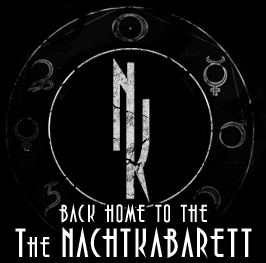
All content & writing by Brad Jaeger © The NACHTKABARETT

Teaser - The next update will feature articles pertaining to the "Final" Cabaret Metro show, and the current status of Glass, post Machina. (Photo credit: PumpkinsMediaMilitia)

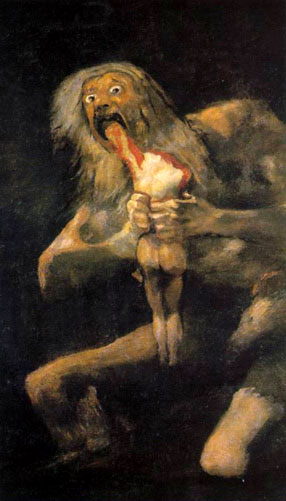 Above: Saturn devouring his children, Francisco Goya, 1820 - 1823
Above: Saturn devouring his children, Francisco Goya, 1820 - 1823
"I say to you that I am the thing itself, but you must not touch me; within me lies the seed of all animals, herbs and ores."- Conversation between Saturn and a chemist, Frankfurt, 1706
Originally an outtake from Adore, rerecorded during the Machina sessions, Satur9 appeared as a B-Side on CR-01 of Machina II. The name, when sounded out, provides the alchemical term we are dealing with - "Saturnine". It would also appear spelled like this on "Judas Ø".
Satur9 makes a nod to the alchemical concept of the "Saturnine Night". The Saturnine Night is a mythological analogy for the production of the philosopher's stone, with a particular focus on the destructive 'saturnine' aspect of antimony, which is a poisonous and base lead-like element that acts as a magnet for all of the toxic and impure qualities within the mixture that could jeopardize the operation. In order for transformation to occur, the antimony must be purified. As stated, this tale was told (like all of alchemy) through oftentimes complex and erudite metaphors and analogies, so as to safeguard the wisdom from falling into the wrong hands.
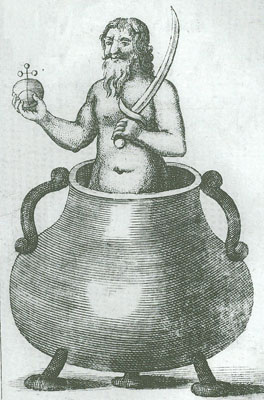 Above: J. Isaak Hollandus, Hand der Philosophen (1667), Vienna edition, 1746
Above: J. Isaak Hollandus, Hand der Philosophen (1667), Vienna edition, 1746
"Behold, in Saturn a Gold lies enclosed (…). Just so man lies now, after his fall, in a great, formless, bestial, dead likeness (…) He is like the coarse stone in Saturn (…) the outer body is a stinking cadaver, because it still lives in poison."- Jacob Bohme, De Signature Rerum
"[N]ature dissolves and joins itself, sublimes and lifts itself up, and grows white, being separated from the feces. And in such a sublimation the more subtile, pure, and essential parts are conjoined; for that with the fiery nature or property lifts up the subtile parts, it separates always the more pure, leaving the grosser at the bottom.- Artpephius, transcribed from "In Pursuit of Gold" by Lapidus
Saturn, who was the Roman equivalent of the Greek god Chronos, was traditionally depicted bearing a bundle of wheat in one hand, and a sickle in the other. These two symbols cemented him as a God with solid foundations in the earth, and the harvest. Similarly, the sickle earned him the reputation of being a cold and unforgiving reaper.
"Once Chronus-Saturn was the proud ruler in the eternally youthful "Golden Age", but since his son Jupiter overthrew him and he, according to the Iliad was, "put under the earth", he is in a pitiful condition: as Father Death, with his sickle in his hand, he now embodies the destructive aspect of time, and represents the original "gate of darkness" in the Work, through which material must pass "in order to be renewed in the light of paradise"- Alexander Roob, reflecting on Aeyrenaeus Philalethes' "Ripley Revived", London, 1677
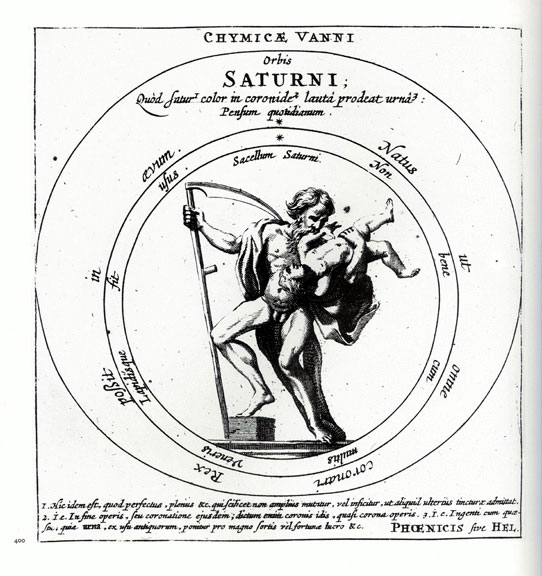 Above: Saturni, Joannes De Monte-Snyder, Chymica vannus, 1666
Above: Saturni, Joannes De Monte-Snyder, Chymica vannus, 1666
"Saturn or Chronos is shown emasculated, like his father Uranus. Having been told that one of his children would dethrone him, he ate them at birth. Jupiter, the last, eluded him by substituting a stone. Saturn's action reflects the Night or Blackness of Dissolution, the Raven's head or Caput Corvi: the Crow which is the Crown of the Work, since there can be no Generation without Putrefaction"- Alchemy & Mysticism: The Hermetic Museum by Alexander Roob
Despite his initially menacing and unflattering depictions, Saturn was later redeemed by prominent alchemists like Agrippa, who in his De Occulta Philosophia referred to Saturn as, the "great, wise and understanding lord, the begetter of silent contemplation (…) [and the] keeper and discoverer of mysteries".
Just as Saturn drew all his children close to him so that he could devour them, so too does the physical antimony, which draws and binds together the toxic elements. On its own, antimony carries very little purpose, with the exception of bringing together the unwanted. Once this occurs, one may purify it with a great flame. The purification complete, the matter is no longer a base and lesser material, but a stone worthy of the philosophers.
The process by which the saturnine must be drawn together, purified and transcended directly parallels humanity's need to do the very same. Likewise, the mythology of Saturn began to be seen as analogue to that of the human condition. Alexander Roob wrote of this, claiming that Saturn became "the patron of the alchemists" and "their central role model".
In order for the transformation to come about, the unworthy antimony must be collected, bound, and purified. Antimony served as the catalyst for collecting that which was not worthy, at which point the flame could be exposed to the wasteful matter, in order to bring about purification and emergence of the philosopher's stone.
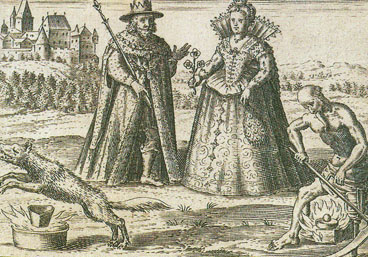 Above: D. Stolcius v. Stolcenberg, Viridarium chymicum, Frankfurt, 1624
Above: D. Stolcius v. Stolcenberg, Viridarium chymicum, Frankfurt, 1624
"For the purification of gold (king) the impurities were alloyed with antimony, which was added to the melt. As antimony attracted and swallowed impurities, it was called the "philosophers' magnet", the "wolf of metals", the "fiery dragon", or the "bath of the king".– Alexander Roob, Alchemy & Mysticism: The Hermetic Museum
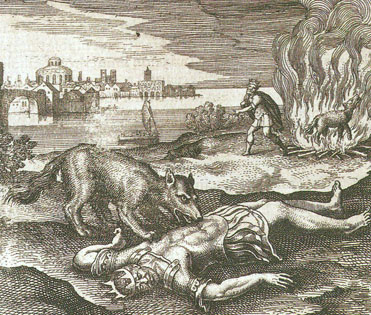 Above: M. Maier, Atalanta fugiens, Oppenheim, 1618
Above: M. Maier, Atalanta fugiens, Oppenheim, 1618
"Take the grey wolf, the child of Saturn (..) and throw him the body of the King. And when he has swallowed him, build a big fire and throw the Wold into it, so that he burns up, and then the King will be liberated again." (Basil Valentine, Twelve Keys)– Alexander Roob, Alchemy & Mysticism: The Hermetic Museum
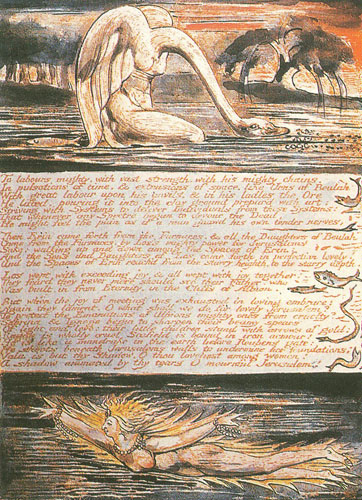 Above: William Blake, Jerusalem, 1804 – 1820
Above: William Blake, Jerusalem, 1804 – 1820
"The swan is the symbol of whitening (Albedo) in the Work. If it rises, "then life had vanquished death, then the king is resurrected".- J. Pernety, Dictionnaire mytho-hermetique, 1758
For everything that has a beginning, there is an end. The journey through the saturnine night culminates in a pure and radiant light. In order to free the spirit, the body must be prepared accordingly.
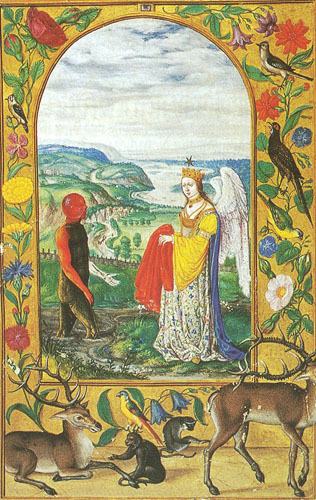 Above: S. Trismosin, Splendor solis, London, 16th century
Above: S. Trismosin, Splendor solis, London, 16th century
"Trismosin tells of an angel (a code name for the mercurial components of the Materia which can be sublimated), which helps "a man, black as a Moor" out of an "unclean slime" (the putrefied sediment in the retort), clads him in crimson and leads him to heaven. This is an image which shows that spirit and soul "are freed from the body by being gently boiled" and later guided back to it, whereby the body becomes stable "in the power of the spirit".- Alexander Roob's Alchemy and Mysticism: The Hermetic Museum
To summarize the entire process, to bring about the philosopher's stone,
"make the black white, and the white black, and you perfect the work."- Artpephius, transcribed from "In Pursuit of Gold" by Lapidus

"What the eyes perceive in herbs or stones or tress is not yet a remedy; the eyes see only the dross."Spagyrical Writings, Paracelsus
Dross is the culminated total of all impurities; the inferior and wasteful material that is skimmed off the top during the process of distillation. This unwanted accumulation of rubbish usually binds itself as alloys in low melting point metals such as aluminum, tin, and lead.
According to Paracelsus, (an astounding alchemist of old) dross was seen as nothing more than undesirable impurities that needed to be removed or purified by the fire of the alchemist. By removing the unwanted elements, one could achieve a purer substance.
As gold was considered a pure metal -the metal which the sun itself imbued its purity and strength into- dross was rightly seen as its antithesis: an impure hodgepodge of relatively useless materials, in which their limited potential could only be achieved by the dissolution of the dross.
This then became another means of explaining the task of the alchemist: by taking the impure and base qualities of lower metals (the dross), the alchemist would subject it to purification (usually of flame), in an attempt to purge it of its impurities and secure it as a pure and living gold. This was completed with the alchemist achieving spiritual purity, enlightenment through gnosis, and transcendence.
Now, if we re-examine Glass with this knowledge, Dross becomes a fitting tale about an individual who is both spiritually and morally lost. A character with a lot of potential, but overcome with imperfections and impurities.
"You say I'm beautiful / Well, I can't help it / You say I'm empty / We all know I'm full of shit"- Excerpt from Dross
Glass performs a moral inventory on himself, only to discover that his soul is tainted with refuse.
Unfortunately, identification of ones lesser qualities are only the first in a laborious series of steps necessary to purify the soul and become enlightened. Glass will have to subject his heart, mind, body and soul to the fire –a solar fire- should he wish to purge the undesirable elements and extend himself the possibility of new life.
"Under the dross, there the remedy lies hidden. First it must be cleansed from the dross, then it is there. This is alchemy…"Spagyrical Writings, Paracelsus

The term “Heavy Metal Machine”, like Dross and Saturnine, holds a double meaning that is worth illuminating.
While outdated, erroneous and factually incorrect, a “Heavy Metal” used to be a term for any metal of a base, dense, or toxic quality.
Several examples include:
- Lead
- Mercury
- Plutonium
- Cobalt
- Copper
- Zinc
This is irrelevant until one applies the term as a metaphor to the song.
In this context, it reinforces the concept of Glass as a Heavy Metal Machine, with far too many base, dense, and toxic qualities in his character. Glass, particularly in this song, is representative of the soulless and vapid mechanism of the industry. Rock and roll, which emerged to shatter the conventional and longstanding ideals held about musicianship, song structure, and traditional values, ends up becoming a Xerox; just a shadow of its former self and a dilution of a once pure solution.
The outcome of rock abandoning its value of free spirit and individualism is that everything becomes sterile and without impact. This continues to degrade until “we’re the metal in their metal machines”. And what does a heavy metal machine push out? Product. The scathingly sarcastic cover Billy did of David Essex’s “Rock On” is a testament to the futility and hollowness of rock and roll in our modern generation.
Unfortunately, I must end it here. Far more reflections are being saved for a forthcoming article on the re-emergence of Glass, in a post-Machina era.
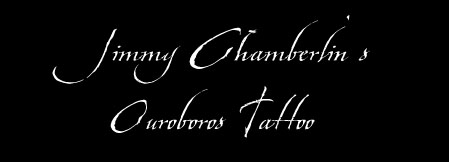
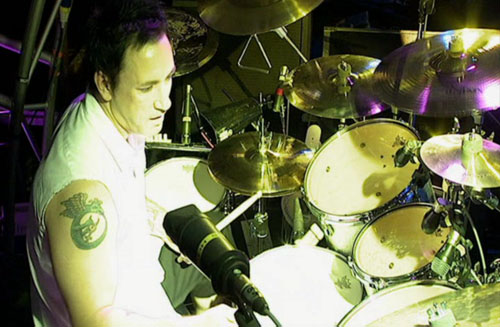 Above: Jimmy Chamberlin's ouroboros tattoo. Screenshot of the tattoo taken from The Smashing Pumpkins DVD release, 'If All Goes Wrong'.
Above: Jimmy Chamberlin's ouroboros tattoo. Screenshot of the tattoo taken from The Smashing Pumpkins DVD release, 'If All Goes Wrong'.
As any inked individual knows, tattoos serve a number of functions. Usually marking an occasion of special significance, tattoos may also serve as continual reminders, illuminating our deepest interests and exposing a highly intimate and intensely personal facet of ourselves to the world.
To adopt such symbols upon the skin is one of the most devotional acts a person may take. Jimmy's intensely personal selection suggests that he was significantly more involved in the development of the Machina concept than fans have previously afforded him.
The tattoo was likely inked somewhere between October 11th – Novemeber 17th, 2000.
The ouroboros that Jimmy bears on his bicep is one of the most ancient and well cited symbols within the alchemical community. It also happens to be one of the most recurrent symbols within the Machina concept, second only in frequency of use next to the alchemical treatise, "It is finished when seven are one".
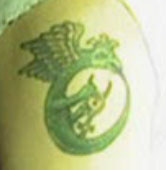 |
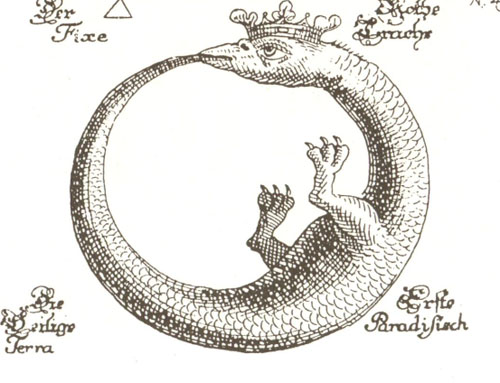 |
Above left: Detail of Jimmy Chamberlin's tattoo, revealing a winged ouroboros holding the symbol of mercury; one of alchemy's most precious sigils and often associated with Hermes/Mercury/Thoth as the founder of the secret art. Above right: a common example of the ouroboros. The ouroboros illustrates the qualities of flux and regeneration, serving simultaneously as "everything and also nothing". A. Elezar, Donum Dei, Erfurt, 1735 |
|
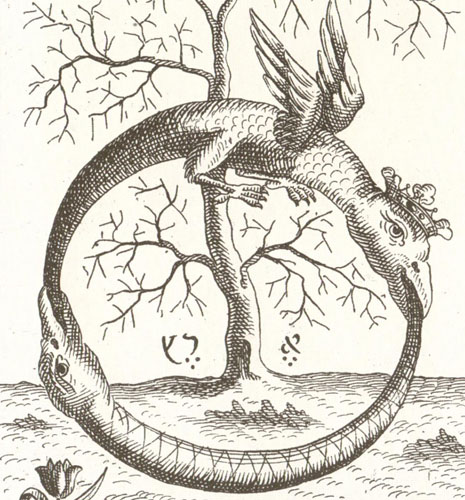
For a thorough explanation of the symbolism of the ouroboros, please refer to Plate XI: The I of the Radio
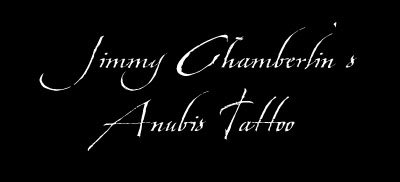
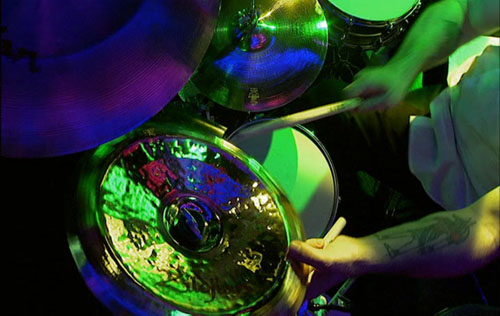 Above: Jimmy Chamberlin's Anubis tattoo. Screenshot taken from The Smashing Pumpkins DVD release, 'If All Goes Wrong'.
Above: Jimmy Chamberlin's Anubis tattoo. Screenshot taken from The Smashing Pumpkins DVD release, 'If All Goes Wrong'.The tattoo which Jimmy bears on the underside of his left forearm is none other than the Jackal-headed Egyptian God, Anubis.
Anubis was primarily associated with the afterlife, served as the protector of cemeteries and was the inventor of "embalming because he helped Isis to preserve her brother Osiris, whose body was the first to be mummified".
Often shown as jackal headed, he :
"was usually black because of his connection with the discolored mummified body and the black earth of the Nile. It was thought that by paying homage to the deity in this form, a worshipper could ward off the scavenging jackals after death."From Mythology: The Illustrated Anthology of World Myth and Storytelling by C. Scott Littleton
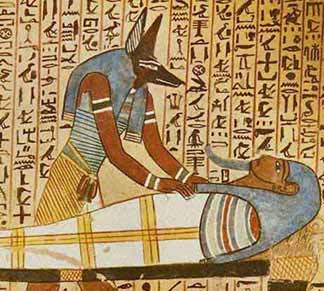 Above: Anubis carrying out his duties as embalmer and psychopomp
Above: Anubis carrying out his duties as embalmer and psychopompAccording to The Book of the Dead, whenever an individual died, it was the task of Anubis to monitor the balance between the heart, and the feather of Ma'at (goddess of truth, morality, and justice). If Anubis found the two to be in balance, the soul was granted into the afterlife to be among their ancestors, and Osiris himself. If the two were found to be out of balance Amemait, (a particularly brutish "devourer of the dead") would consume the heart raw, and the soul was forever extinguished.
Anubis shared many traits with another mythic figure important to the symbolism of Machina - Hermes. Both Gods operated as psychopomps, directing newly departed souls to the afterworld. Their similarities were well noted by the Romans in particular, who combined Greek Hermes and Egyptian Anubis into a unique deity known as Hermanubis.
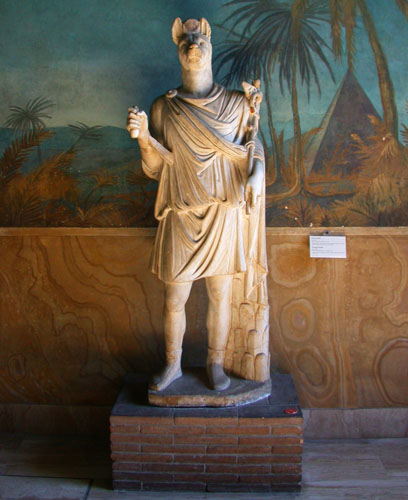 Above: A statue of Hermanubis. The figure retains the jackal-headed quality of Anubis, while adopting Hermes' staff, the caduceus.
Above: A statue of Hermanubis. The figure retains the jackal-headed quality of Anubis, while adopting Hermes' staff, the caduceus.Anubis eventually lost some of his power and significance during the Middle Kingdom when Osiris began to take hold of the common worshipper. It was at this point that Anubis largely adopted his task of observing the balance in the weighing of the heart, as well as his function in the pantheon shifting primarily to the embalming of the recently deceased.
While we know that the ouroboros tattoo first appeared between mid October to mid November, the timeframe for Jimmy's Anubis tattoo is significantly less precise. What we do know is that it appeared roughly 8-10 months prior to the ouroboros tattoo. That being said, the best approximate date that can be offered at this time is circa Nov 1999 – Feb 2000.
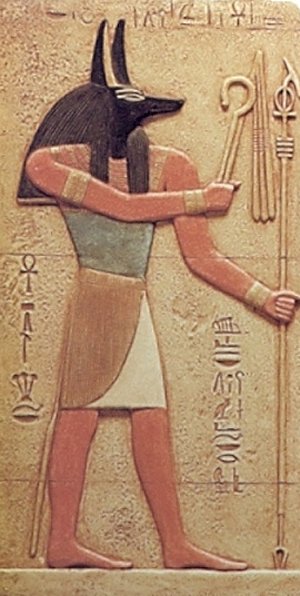 |
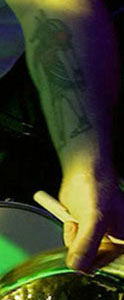 |
Above Left: Anubis Above Right: Detail of Jimmy's Anubis tattoo |
|
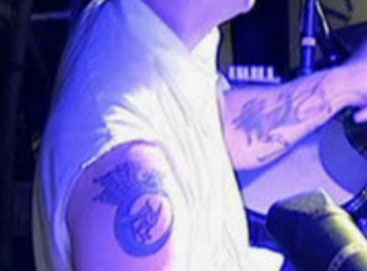 Above: Both ouroboros and Anubis tattoos visible. In Anubis' hand can be seen his ceremonial staff
Above: Both ouroboros and Anubis tattoos visible. In Anubis' hand can be seen his ceremonial staff
